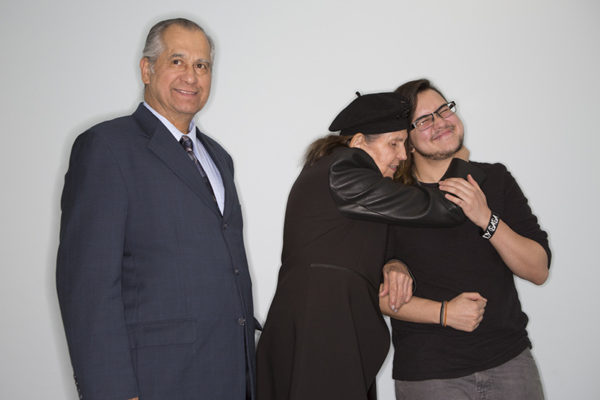

This comic strip by Nate Restrepo, Illustration ’19, describes some of the milestones in his gender transition.
On a chilly Saturday in November, Maria Restrepo Courtos, an alumna in her 80s, barrels across the parking lot of the Brentwood, New York, public library in a trim, stylish coat, beret, and chunky heels. Her eldest son, Bernabé “Bernie” Restrepo, Patternmaking Technology ’79, clings to her arm, smiling grandly. Bernie’s son Nate, Illustration ’19, welcomes them at the front door. All three are eager to tell their stories. Nate, with long hair, lip rings, and a game-for-anything enthusiasm, comes across as a quirky, confident, super-friendly artist. He also happens to be transgender. I first encountered him at FIT’s 2017 commencement, where he delivered an inspirational valedictory address (he earned his associate’s degree that year) about the courage to come out to his family and friends, and the courage his family needed to emigrate from Colombia. Their gratitude to FIT was palpable: I had to meet them.
The library staff greets Maria by name, and we sit down to talk. In 1965, as is common with immigrant families, she left her husband and children and arrived in New York with nothing but hope and a fierce love of America. “I decided to give my children a chance for a good life,” she says. “I could not do that in Bogotá.” To learn English and improve her design skills, she took night classes at FIT while working at a knitting mill in Queens. An FIT workshop in fashion planning and coordination, a class about trends in silhouettes and colors, “opened all the doors to the industry,” she recalls. Her patternmaking professor, Harry Greenberg, was the production manager at Stacy Ames, and that connection landed her an assistant designer job at the company.
One by one, Maria brought her five children to the U.S. Bernie arrived in 1968 and, after working at the New York Hilton for a few years, he came to FIT. At 29, he was hired as a patternmaker, converting designers’ sketches into patterns and analyzing factory samples. Today, most patternmakers work overseas, and he is one of the few remaining in the city. He works for Jump Design Group, which sells to Macy’s, Nordstrom, and other stores.
“It’s a beautiful job, but it’s a lot of pressure,” Bernie says. “You have to meet tight delivery dates, and everything has to be perfect.”
Maria designed for more than 30 years, at Barbara Dance Frocks, Liz Claiborne, and for a short-lived family business, Maria Designs New York, on 40th Street. She retired in 1997.
Nate, born Natali, realized he was transgender at 16, after a year of thinking he might be a lesbian. He told his mother on his 17th birthday, in 2008, seven years before Caitlyn Jenner appeared on the cover of Vanity Fair. It did not go well: She wasn’t ready to accept him as trans. But a few years later, she asked, out of the blue, if he wanted to be called Nate.
“It was oddly uneventful,” he says. “I guess it just had to stew for a while.” He didn’t come out to his father until he began hormone treatments in 2015. He wrote Bernie a letter, but they never discussed it.
“There was no need to respond,” Bernie says. “I understood absolutely.”
Still, when I interview them, Maria keeps referring to Nate as “she,” and Bernie slips up too. It’s surprising, because Nate passes: you wouldn’t know he was anything but biologically male. But for those who raised him as a girl, remembering the new pronoun might not be so easy.
Before he transferred to FIT, Nate was in a communication arts program at Virginia Commonwealth University, and not doing well. He wasn’t interested in the coursework and wasn’t making friends. He moved back to New York, and when a high school buddy recommended FIT, Nate applied for Illustration.
“At the time, I was really skeptical of art schools,” he says. “It helped that my father and his mother had come here.”
He appreciates that the faculty, working artists themselves, teach not just how to make art but also how to make a living. And he relies on his “crew”—fellow FIT students from all over the world, many queer and a few trans—who critique each other’s work honestly. “I’m in the right major, finally,” he says. “I’ve always felt like an outsider, but not here.”
Nate also appreciates FIT’s culture of acceptance. No professor or peer has ever disparaged his identity. And he was very happy to see FIT’s new inclusive restroom signs that welcome all male-identified people into the men’s.
“Ideally, it shouldn’t have to be stated,” he says. “The reality is, there is a lot of transphobia rampant in mainstream culture. The bathroom signs are a step in the right direction.”
We go to lunch at an Islip diner heavily bedizened with Christmas lights and plastic icicle trim. One by one, the servers and the manager stop by to say hello to Maria and Bernie. The Restrepos are truly part of this community. And here, in their element, it’s clear that all three are pioneers in their own way.
– By Jonathan Vatner
Top Photo: Three FIT grads: Bernie, Maria, and Nate Restrepo. Photo: Nick Parisse
Originally published in the spring 2018 issue of Hue.